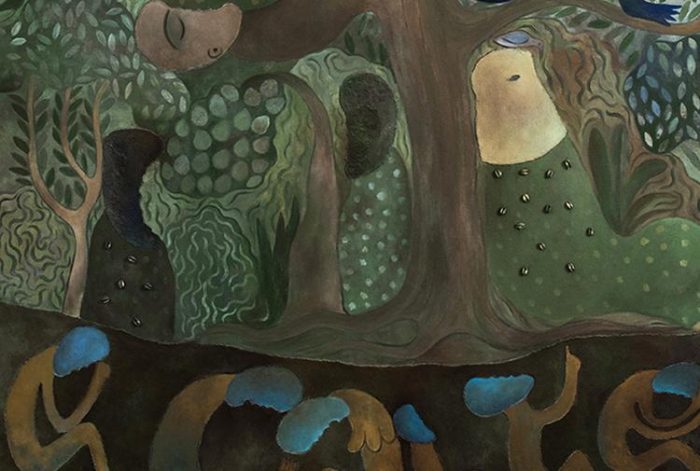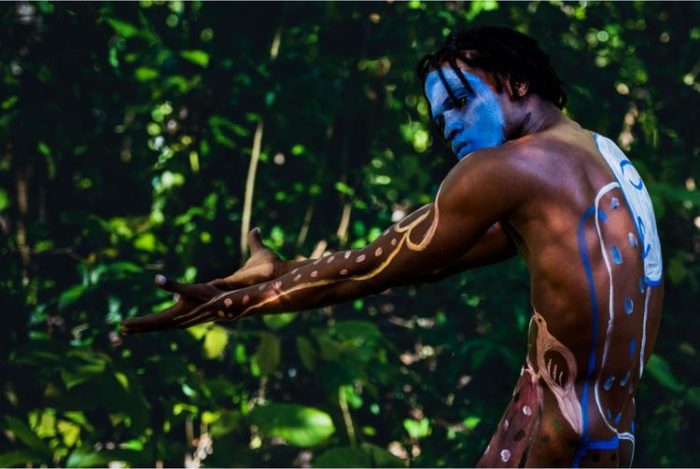
Manuel Mendive finds magic in the rituals of his native Cuba, but I cannot swear that he ever experienced them at first hand. That could be why they seem at once so mournful and so playful—and I have added this to other recent reports on art of the Americas as a longer review and my latest upload. In photographs at the Bronx Museum in collaboration with John Rowe, bare-chested actors comport with masks in the uncertain space of nature. The disguise may be as simple as paper, obscuring faces without suggesting that they are anything but ordinary behind the mask. They may be face paint directly on the skin, in a fluorescent blue or green that really does approach magic. Like the cast’s movements, they can look savage, decorative, clumsy, or just a put-on.

The masks continue past the lobby and into paintings, through November 4, where they take over more completely from the faces. There Mendive’s figures, at full length, look right out of Mr. Potato Head, but without bright red noses. Sharing an often crowded scene, they look half-ashamed of themselves and each other. The landscapes are idyllic all the same, even without the lushness of a color photograph, but all the more awkward for that. A figure reaching for a tree might be Eve in a lost Eden—all the more pointed by appearing male. Another has three legs and animal feet, like a poor excuse for the devil.
A mask can also serve for protection, and so can the black arts of photography and painting. While I cannot quite assign a name to the irregularly shaped canvas, it may come closest to shields, as for Mark Grotjahn in abstraction. Freestanding sculpture could serve as protection, too, from prying eyes or the elements. Pillars, painted inside and out with much the same tropical scenery, leave part of one side open. A Cuban artist may well have needed shelter to pursue an interest in ritual or religion. Just do not expect to enter or to touch.
Where another Cuban, Belkis Ayón, found her self-image in Christianity, Mendive bases his on the Yuroba religion of western Africa. Like other Caribbean artists, he is interested in a transcontinental diaspora of people and culture. Eclecticism wins out over absorption or salvation, much as in his diversity of media. The museum calls its small retrospective “Nature, Spirit, and Body,” which sounds ever so profound, but he puts in question whether spirit will ever win out over nature or the body. Besides, he has lived and worked not in paradise or the jungle, but in Havana. The photographs are staged, and the paintings and sculptures are works of the imagination.

Born 1944, Mendive could still pass as an emerging artist—and not just because he is all but new to New York. The show might seem to belong to a much younger artist or, given its mix of media, three or four of them at that. And the museum often makes up for its own low profile by displaying older artists that it sees as close to the streets, like Martin Wong after his death. Here it picks up the hot themes of Latin American art, culture and wisdom, gender, and people of color. One might have seen masks only recently in photos from Gauri Gill at MoMA PS1. If one expects an essential Afro-Cuban identity from either artist, Gill reports instead on India.
The show has a slippery physical boundary as well. A sign pointing to the south gallery takes one to painting and sculpture by Diana Al-Hadid, but by way of a spacious passage with a wide-screen video. There Mendive’s performers immerse themselves in a larger, more inviting, and more impenetrable landscape, with close-ups of insects and the sounds of birds. Successively male and female, they slink around like Clarissa Tossin’s dancer in “Pacha, Llaqta, Wasichay,” a show of indigenous American art and culture at the Whitney. Mendive’s familiarity despite himself can have the drawback of his seeming stale even before his opening. His references may be at best elusive. He is, though, old enough to intend the slipperiness, the magic, and comedy.
MANUEL MENDIVE: NATURE, SPIRIT, AND BODY at The Bronx Museum
July 25, 2018 to November 4, 2018
-John Haber

John Haber is a deft practitioner of the craft of condescension but i cannot swear he has ever been moved by art.